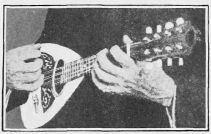Mandolin Self Instructor, online tutorial - Page 16
A simplified self learning system for the Mandolin with tuning instruction, song folio, chord diagrams, sheet music and PDF for printing. By ZARH MYRON BICKFORD
| Share page | Visit Us On FB |
|
THE DOWN STROKE (Continued) |
||
|
As previously explained, the back of the nail, or more properly, the side or outer corner of it, should be allowed to rest against the guardplate or top of the instrument as the hand drops toward the strings for the down stroke, and, during the early stages of practice, this finger should leave the top of the instrument when the hand is brought back to its start- ing point, ready for another down stroke. As the speed of the strokes increases, however, and the length slightly de- creases, this finger does not leave the top, but glides back and forth easily, following the motion of the hand. In this connection, Munier, the great Italian authority, says: "The other ringers of the right hand (aside from the thumb and first finger) should be relaxed; the little finger should glide on the sounding-board and serves as a guide for making the tremolo." Tartaglia another eminent authority, also says: "The little finger should not be stuck fast to the sounding- board, but it must glide easily, following the movement of the hand." Pietrapertosa, the famous authority of Paris, also says: "... the little finger resting on the guardplate, but without force, for this finger, moving along the top, acts as a guide to the hand in the movement of the pick against the strings." |
||
 |
||
|
It has been the experience of the author that a very light contact of the little finger with the instrument serves as a guide for the movement of the hand, both in single strokes and in the tremolo. The single exception, when its touch- ing might be a matter of choice, is when playing two or more strings with the tremolo, as in "duo" playing. While on the subject of down and up strokes, it should be added that the wrist joint does not move in the least when making the strokes, the entire motion being made by swinging the hand from its pivotal point—the middle of the forearm. This swing causes a rotary motion of the two bones in the forearm, but the wrist itself is held in a perfectly fixed, although relaxed condition. |
||
|
THE DOWN AND UP STROKE |
||
|
While the up stroke of the bow in playing the violin plays an almost equally important part with that of the down
bow, the same cannot be said to be true with the up stroke of the pick. For example, two consecutive notes on the violin are frequently played with alternating down and up bows, no matter what their speed may be, while the same notes played on the mandolin would require an entirely different stroke from the right hand. The only definite rule that can be given at this stage is that notes which are played slowly are to be taken entirely with down strokes, while those re- quiring more speed than is convenient for consecutive down strokes must be played with alternating down and up strokes. Since the up stroke is most often used immediately following the down stroke, it is suggested that a down stroke
be taken, as previously explained, for example, on the G string, allowing the pick to rest firmly against the D string. It should also be explained that, while about a quarter inch of the pick projects below the nail of the first finger,
the only part that actually touches the pair of strings as the stroke is made, is the very point—less than a thirty-second of an inch. If the pick is held at the suggested angle, the projection of the point of the pick as it rests against the D string after the G string has been struck, will be but slightly more than the thirty-second part of an inch. After having allowed the pick to rest for an instant, with all muscles perfectly relaxed, the hand and pick are brought
back with a quick motion to the exact point from which the down stroke was started and following the very same angle or imaginary "groove," but touching the strings on this upward journey, the same as when the hand went down. If the pick is "held very loosely, both strings of the pair will be vibrated when taking the up stroke, since the point of the pick*will glide quickly across them, the same as on the down stroke. It is most essential that the directions for using the very point of the pick be carefully followed, especially in taking the up stroke and also that the pick merely rest between the thumb and finger instead of being gripped, otherwise the slight angle at which it is held will cause it to slip under the first string encountered. This is disastrous, as it not only prevents striking both strings, but causes the pick to get caught under the string so that the stroke cannot be finished without an accident of some sort. |
||